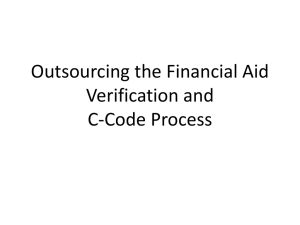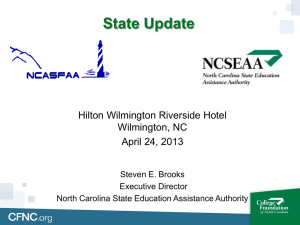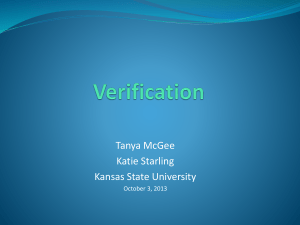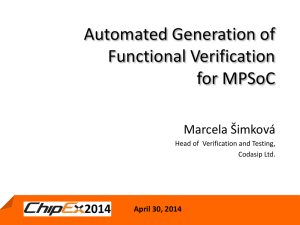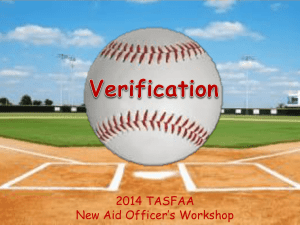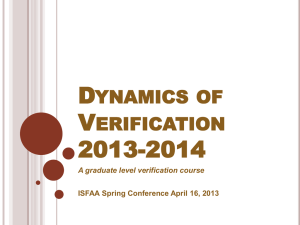click this link - Work Supports Strategies
advertisement
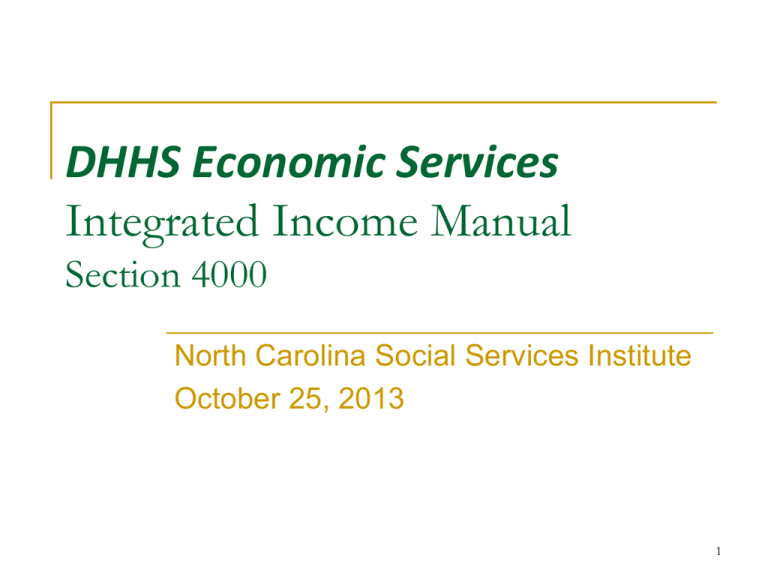
DHHS Economic Services Integrated Income Manual Section 4000 North Carolina Social Services Institute October 25, 2013 1 Agenda Integrated Eligibility (IE) Efforts Overview History Development of Economic Benefits Policy Governance Board (EBPGB) Role of Work Support Strategies Committee & Policy Review Subcommittee Integrated Policy Manual Background Development of the Income Section Next Steps 2 Overview of IE Efforts DHHS has undertaken a large initiative to streamline eligibility determination processes This falls under the tenets and Action Plan steps of Work Support Strategies, and is possible with the implementation of NCFAST. 1. Formalize and strengthen county and state partnerships. 2. Develop organizational culture that supports new service delivery system. 3. Build infrastructure to support new service delivery system. 4. Communicate the vision for a new service delivery system. 5. Increase capacity for data collection and analysis. 6. Reduce burdensome policies and procedures. 7. Perform staff development and readiness activities. 3 History Integrated Eligibility work includes: Includes all DHHS economic benefits programs – Medicaid (Medicaid Aged, Blind, and Disabled; Medicaid Family and Children; NC Health Choice), Food and Nutrition Services (FNS), Work First (WF), Refugee Assistance (RA), Subsidized Child Care (SCC), Special Assistance (SA) Energy Programs (EP) Programs share similar standards for reporting and verifying personal and financial information Applicants and beneficiaries have been required to undergo separate application and redetermination processes for each benefit. 4 WSS Action Step 1 Formalize and strengthen county/state partnerships. • Develop cross-program state and county leadership bodies. • Economic Benefits Policy Governance Board • Work Support Strategies Committee • • Policy Review Subcommittee Develop and implement more systemic state-county communication process. 5 Economic Benefits Policy Governance Board (EBPGB) Responsibility - to provide a formalized, transparent, and meaningful platform for developing policy across programs administered by DHHS, communicating changes in a timely manner, and soliciting input where appropriate. Membership – This Board has membership from the four Divisions involved in WSS: The Division of Social Services (DSS) ) represented by Dean Simpson and David Locklear; The Division of Aging and Adult Services (DAAS) represented by Chris Urso; The Division of Medical Assistance (DMA) ) represented by Carolyn McClanahan; and The Division of Child Development and Early Education (DCDEE) represented by Ron Byrd and Kim Miller 6 EBPGB: Policy Review Subcommittee 10 Representatives from each of the three NCACDSS regions and seven members from NCSSA. Role is to ensure the policy is clear, concise, and understandable and has the ability to be implemented locally. Replaced the old, siloed Economic Services Committee Co-Chairs: Brenda Jackson, Cumberland Co. DSS Cathy Beil, NCSSA & Mecklenburg Co. DSS Yvette Smith, Iredell Co. DSS Susan Moore, Lenoir Co. DSS 7 Integrated Manual: Background DHHS workgroup identified several strategies, including: Aligning countable and non-countable income types across programs; Aligning verification and reporting requirements; Developing a common method for calculating gross income across programs; Developing a common procedure for collecting eligibility information; and Changes are expected to help eliminate redundant work activities and eligibility processes; reduce administrative resources; reduce unnecessary client contact with the DSSs; and provide increased program accuracy. 8 Integrated Manual: Background The DHHS workgroup had the tedious process of identifying and aligning, where possible, income across all programs. 9 Examples This example is related to how SA income affects ALL benefit programs in determining eligibility. Having this information in one manual saves time and reduces errors in determining financial eligibility for the universal worker. Special Assistance: State-County Special Assistance for Adults (SA) provides a cash supplement to help low- income individuals residing in adult care homes (such as assisted living). Medicaid, SA, Work First, and Subsidized Child Care do not count. FNS and Energy are the only programs that count Special Assistance Check out the “sources of income” Chart for FNS: http://info.dhhs.state.nc.us/olm/manuals/dss/ei-30/man/FSs263.htm#P12_82 Energy: http://info.dhhs.state.nc.us/olm/manuals/dss/ei-40/man/EPs30008.htm#P267_16924 10 Writing the Manual: An Overview The North Carolina Economic Benefits Integrated Income Manual requires workers to rely on the policies as written in the manual and to provide detailed documentation that supports eligibility decisions. 11 Integrated Manual: Overview DHHS is aligning policy and converting manuals to this new format in phases, beginning with the INCOME SECTION. The next planned section is the RESOURCES SECTION. The new manual sections using a new software and it will be hosted on a different website from the current manual. The new manuals will employ Adobe RoboHelp for a user friendly, easily maneuverable manual site. You will notice that this is the same software that is used for NC FAST Help. 12 Integrated Manual: Income Section Condensed, very succinct Few case examples Contains list of income types and which ones are countable Defines base periods Lists required verifications including verification hierarchy and instructions for documentation of verification; How to determine gross income What deductions apply How to respond to changes in income 13 Income Section INCOME SECTION DHHS reviewed nearly 200 types of countable and noncountable income described in program service manuals existed: not in response to federal or state requirements, but rather to provide specific guidance in the “gray areas” of income determination To respond to rare types of income. Income types that were derived directly from federal regulations were often differently defined, described or nuanced by the various programs unnecessarily. Some income types were duplicative, altogether outdated or no longer considered relevant. 14 Income Types Agreed upon name for the income category Income types were consolidated under one name. Others were added to accommodate complex policies that could not be adjusted (e.g. Tobacco Allotments income types, VA income types). Some were renamed to provide more clarity. Countable if it is counted by at least one program. Countable income types are divided into “earned” and “unearned” categories. Brief definition and/or a clarifying comment to determine under what circumstances the income type should be counted. List and definition included for non-countable income types. 15 Exceptions to Alignment of Income Types and Treatment Special base periods: If a special base period is needed for an income type, the special base period has been included. For example, child support calls for a special base period of 2 months if representative. In this instance, the general base period of 1 month suggested across income types does not create a snapshot of income that is representative, due to the often infrequent nature of child support payments. Special Budgeting Notes: If calculating an income type to represent a gross monthly amount is not readily intuitive to the case manager, a budgeting method is detailed. Special Verification Notes: If special verification that is not included in the general verification instructions, it is listed here. Comments-includes additional information that does not fit into one of the other 16 General Rule: Evaluate the case for all income that will be available during the certification period. Establish a current and representative estimate of gross earned and unearned income that will be available to the budget unit during the certification period. 17 Income Verification Verification of all income is required at application and review/redetermination and at change in circumstance as designated by each program. Verifications are used to support evidence (information) in the determination of program eligibility. The applicant/recipient/claimant’s income is the “evidence” used to determine eligibility. Pay stubs are examples of sources of verification used to support the evidence. 18 Verification Sources Four main sources of verification: 1. 2. 3. 4. Electronic matching is the primary income verification source for income received through Social Security, Employment Security Commission (UIB), Work Number, etc. Documentary evidence for income verification includes wage stubs, award letters, banks statements, etc. The applicant or the household has primary responsibility for providing documentary evidence to support statements on the application and to resolve any questionable information. Documentary evidence may be provided in person, by mail, or through an authorized representative. Accept any reasonable documentary evidence if the verification adequately proves the information provided on the application. A collateral contact may be necessary when documentary evidence cannot be obtained, or is insufficient to make eligibility determination or determination of the correct benefit level. A collateral contact is a person knowledgeable enough about the information needed to provide an accurate statement of verification. The DSS is responsible for obtaining verification from acceptable collateral contacts. Client’s Statement is acceptable in some circumstances based on individual program policy unless otherwise questionable. Example: Client’s statement can be accepted as verification of income that results in ineligibility, decrease, or termination of Food and Nutrition Services. The DSS must assist the applicant or household in obtaining verification as needed. 19 Income Verification: General Guidelines Use reasonable documentation to verify income. Avoid over-verification (e.g. requiring excessive pieces of evidence for any one item or requesting verification that is not needed to determine eligibility.) Do not require additional verification once the accuracy of a written or verbal statement has been established. Do not require a specific type of verification when various types are adequate and available. Only re-verify income information when required by program policy or when different or conflicting information is presented. If fraud is suspected, determine if a referral for fraud or for frontend verification should be made. 20 Verification Method Hierarchy The Electronic Online Verification (OVS) is required for all programs and all income types. Only pursue other methods if there is a discrepancy or if electronic verification is not available. Accept verifications that reasonably establish eligibility. 21 Documentation of Verification Income documentation is required for all cases. Documentation means the type of verification and a summary of the information obtained has been entered in the appropriate evidences in NC FAST. Documentation must be detailed so that a County, State, or Federal reviewer is able to determine the reasonableness of the determination. For example, when income is verified by the presentation of pay stubs, the gross amount of income on each pay stub, and the frequency of receipt of income is documented in NC FAST evidence(s) or case record. 22 Documentation Required For: Applicant or beneficiary statements regarding available income; including client’s statement of no income. The source and type of income, and a collateral contact if one is necessary. Efforts to determine employment and exploration of potential unearned income Copies of correspondence and documents, forms, notification. Amount and type of earned and unearned income and any operational expenses. Base period used and the income available. Changes which may occur in the future. Flag the case. Other facts, information, or dates used to support your decision 23 Determining Gross Income When determining projected income for the certification period, count gross monthly income. If income is received other than monthly or if income fluctuates, convert to a monthly amount that is current and representative for each pay period. NC FAST will convert income to a monthly amount based on the frequency entered. 24 Determining Gross Income: Base Periods Representative: Base periods are the basis for determining income eligibility. The base period establishes a set period of time for workers to create a “snapshot” of a budget unit’s income and for which income must be verified. The base period should be an accurate representation of the income the household is expected to have available during the certification period. 25 Determining Gross Income: Base Periods One Month: The base period for most income is the month prior to the month of application or redetermination, if representative. Three Months: The base period for child support, spousal support and alimony is the three months prior to the month of application or redetermination, if representative. Add the months together and average (divide by 3). Twelve Months: if the income is received annually or from selfemployment, the base period is 12 months. Special base periods: Certain types of income require special base periods, particularly if the income is not stable or predictable. Exceptions to the base periods are listed in 4030.1 and 4030.2 Countable Income in the column labeled “Special Base Periods” 26 Determining Gross Income: Base Periods Not Representative If the base period income is not representative, explore using alternative budgeting methods such as projecting or averaging income. Determine which budgeting method is the most representative estimate of the budget unit’s income over the certification period. Project income using the best available information about the number of hours, rate of pay, and frequency of pay expected to be received over the certification period. If you use an alternate budgeting method you must document why the base period is not representative and how you determined what base period is used. 27 Determining Gross Income: Base Periods Not Representative Averaging is used when the budget unit’s income fluctuates across pay periods. Total the income for all pay periods and divide by the total pay periods to reach an average income across pay periods. Do not round. Enter average income into NC FAST along with the appropriate frequency. 28 Formulas to Convert or Average Incomes NC FAST uses the following formulas to convert or average incomes: If received weekly, multiply by 4.3 If received bi-weekly, multiply by 2.15 If received semi-monthly, multiply by 2 If received quarterly, divide by 3 If received monthly, use the monthly gross If received semi-annually, divide by 6 If received annually, divide by 12 29 Deductions, Exclusions and Disregards These have been grouped in the Integrated Income Manual section by the type of deduction. These are found in an easy to use chart. 30 Change in Income When a change is reported react to changes based on program policy. A Change in earned income is: New employment (which includes initial employment as well as a change of job with the same or a different employer) An increase or decrease in rate of pay An increase or decrease in the required number of hours worked Termination of income A change in unearned income is: Beginning or termination of unearned income An increase or decrease in the amount of unearned income 31 Budgeting New, Changed or Terminated Income A change may be reported during the application period, during the certification period or during the redetermination period. New or changed Income: begin budgeting the representative income the month after the month in which the notice expires. Use any earned or unearned income received to project income forward. If no income has been received then use the best available information about the number of hours, rate of pay, and frequency of pay expected to be received over the certification period. Terminated Income: do not count the source beyond the month the income terminates. 32 Next Steps Current location: http://www.ncwss.com/manual/index.html Transfer the Manual to permanent site Begin work on the Resources section Publish the paper-based Integrated Application Add MAGI Sections Archive Income sections of existing manuals 33 Questions? 34 Key Contacts Chris Urso, SA Program Administrator Division of Aging and Adult Services chris.urso@dhhs.nc.gov Carolyn McClanahan, Chief MA Eligibility Division of Medical Assistance carolyn.mcclanahan@dhhs.nc.gov Ron Byrd, Chief of Child Care Subsidy Division of Child Development and Early Education ron.byrd@dhhs.nc.gov David Locklear, Acting Chief, Economic and Family Services Division of Social Services david.locklear@dhhs.nc.gov 35
